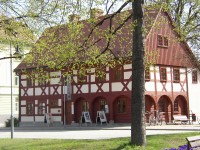Der silberne Suppenlöffel wurde von Paul Wilhelm Streck (1853-1928), einem Nieskyer Goldschmied, hergestellt.
Auf dem Griff ist auf der Vorderseite "P. P. 1. Mai 1892" eingraviert. Das könnte auf einen früheren Besitzer hinweisen, der an diesem Tag ein besonderes Ereignis beging.
Das Goldschmiedegeschäft Streck befand sich am Zinzendorfplatz 4 an der Ecke zur Muskauer Straße, im Volksmund "Strecks Eck" genannt. Das Gebäude wurde im April 1945 zerstört. Im Jahr 1960 entstand an der Stelle ein vierstöckiger Wohnblock mit Ladenunterbauten (Frisörsalon "Sybille").
en

















